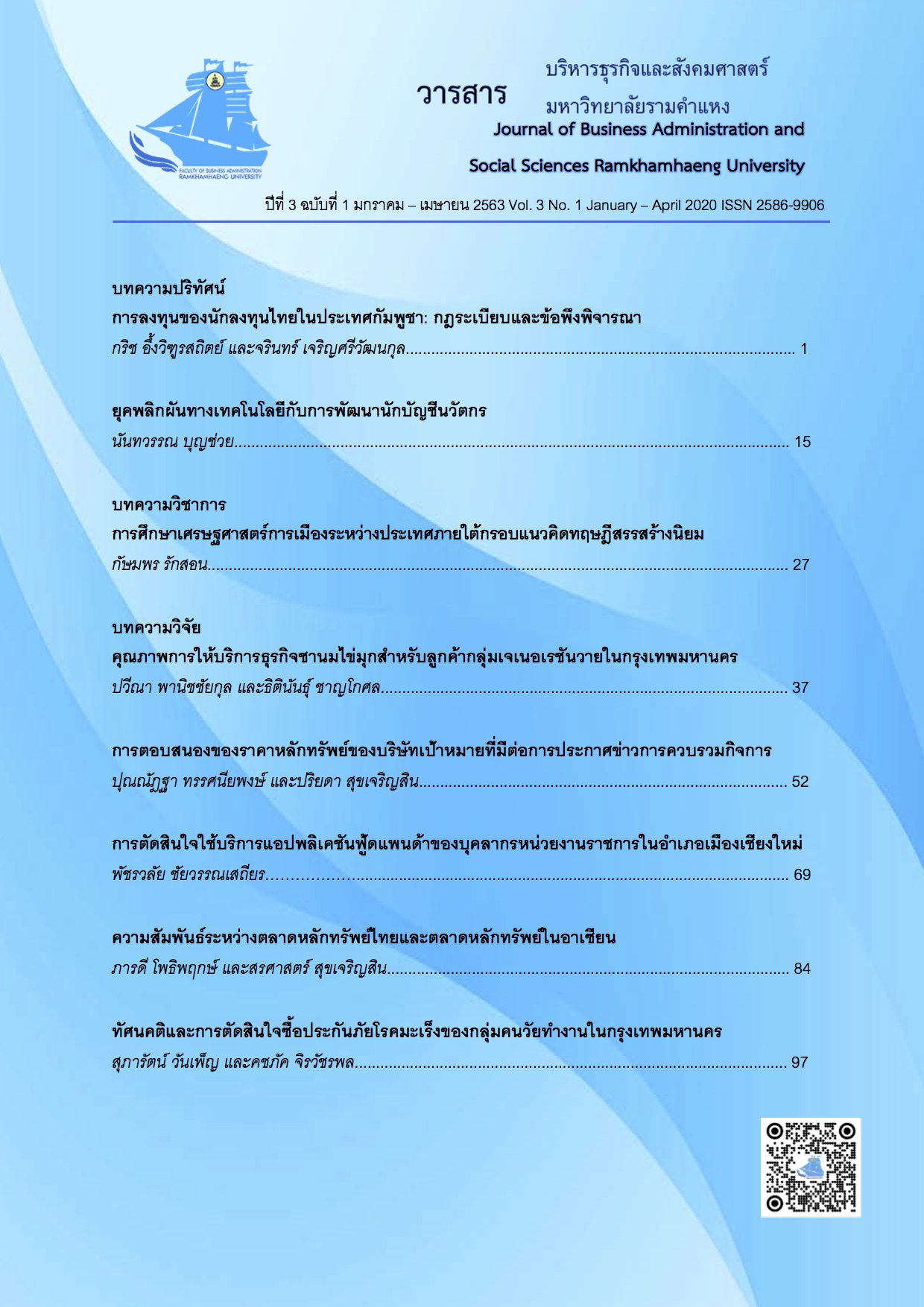The Decisions by Government Personnel in Mueang Chiang Mai District to Use the Foodpanda Application
Main Article Content
Abstract
In this research investigation, the researcher examines the decisions by government personnel in Mueang Chiang Mai district to use the Foodpanda application. The researcher also compares the decisions to use this application as classified by the differences in the demographic factors of these personnel. The sample population consisted of 400 personnel in public agencies in Mueang Chiang Mai district who have used the food delivery service of the Foodpanda application more than once.
Findings showed that the highest proportion of the personnel were females, aged 30-40 years, single, with a bachelor’s degree, being government officials with an average monthly income from 10,000 to 25,000 baht. The members of the sample population paid attention to marketing mix factors at a high level overall and in each aspect. At the highest level was the aspect of physical environment. Next in descending order were the aspects of employees; processes; products and services; prices; distribution channels; and promotional activities. The hypothesis test showed that the members of the sample population who differed in educational level exhibited differences in the attention paid to the marketing mix in the decisions to use the Foodpanda application at the statistically significant level of .05. This research would benefit food delivery business operators and enable them to improve the efficiency of their services and respond to the needs of the personnel under study to enable them to use the food delivery application more effectively.
Article Details
เนื้อหาและข้อมูลในบทความที่ลงตีพิมพ์ในวารสารบริหารธุรกิจและสังคมศาสตร์ มหาวิทยาลัยรามคำแหง ถือเป็นข้อคิดเห็นและความรับผิดชอบของผู้เขียนบทความโดยตรง ซึ่งกองบรรณาธิการไม่จำเป็นต้องเห็นด้วย หรือร่วมรับผิดชอบใดๆ
บทความ ข้อมูล เนื้อหา รูปภาพ ฯลฯ ที่ได้รับการตีพิมพ์ในวารสารบริหารธุรกิจและสังคมศาสตร์ มหาวิทยาลัยรามคำแหง ถือเป็นลิขสิทธิ์ของวารสารบริหารธุรกิจและสังคมศาสตร์ มหาวิทยาลัยรามคำแหง หากบุคคลหรือหน่วยงานใดต้องการนำบทความทั้งหมดหรือส่วนหนึ่งส่วนใดไปเผยแพร่ต่อ หรือเพื่อกระทำการใดๆ จะต้องได้รับอนุญาตเป็นลายลักษณ์อักษรจากวารสารบริหารธุรกิจและสังคมศาสตร์ มหาวิทยาลัยรามคำแหง ก่อนเท่านั้น
References
ฉัตยาพร เสมอใจ. (2550). พฤติกรรมผู้บริโภค. กรุงเทพมหานคร: ซีเอ็ดยูเคชั่น.
ชนิภา ช่วยระดม. (2561). ปัจจัยส่วนประสมทางการตลาดที่ส่งผลต่อการเลือกใช้บริการสั่งซื้ออาหารผ่าน Foodpanda Application ในเขตกรุงเทพมหานคร. วารสารบริหารธุรกิจและสังคมศาสตร์ มหาวิทยาลัยรามคำแหง, 1(2), 43-55.
ณัฐศาสตร์ ปัญญานะ และวัชรพจน์ ทรัพย์สงวนบุญ. (2562). ปัจจัยที่มีผลต่อการตัดสินใจใช้บริการอาหารตามสั่งแบบจัดส่ง. วารสารเศรษฐศาสตร์และบริหารธุรกิจ มหาวิทยาลัยทักษิณ, 11(1), 53-66.
พิมพุมผกา บุญธนาพีรัชต์. (2560). ปัจจัยส่วนประสมทางการตลาดที่มีผลต่อการตัดสินใจใช้บริการ Food Delivery ในเขตกรุงเทพมหานครและปริมณฑล. การค้นคว้าอิสระบริหารธุรกิจมหาบัณฑิต. มหาวิทยาลัยธรรมศาสตร์.
ศิริวรรณ เสรีรัตน์, ศุภร เสรีย์รัตน์, องอาจ ปทะวานิช, และปริญ ลักษิตานนท์. (2546). การบริหารการตลาดยุคใหม่. กรุงเทพมหานคร: ธีระฟิล์ม และไซเท็กซ์.
สสินาท แสงทองฉาย. (2560). ปัจจัยส่วนประสมทางการตลาดที่มีอิทธิพลต่อพฤติกรรมของผู้บริโภคกลุ่มดิจิทัลเนทีพไทยในการเลือกใช้แอปพลิเคชันสั่งและจัดส่งอาหารในเขตกรุงเทพมหานคร. วิทยานิพนธ์นิเทศศาสตรมหาบัณฑิต, จุฬาลงกรณ์มหาวิทยาลัย.
สุรคุณ คุณสัตยานนท์. (2558). ปัจจัยที่ส่งผลต่อการตัดสินใจเลือกใช้บริการคาร์แคร์ของผู้บริโภคในจังหวัดกรุงเทพมหานคร. การค้นคว้าอิสระบริหารธุรกิจมหาบัณฑิต, มหาวิทยาลัยกรุงเทพ.
อาภาภัทร บุญรอด. (2562). สังคมเหงาในยุคดิจิทัล. สืบค้นเมื่อ 18 พฤศจิกายน 2562, จาก https://www.bangkokbiznews.com/blog/detail/649103.
Cochran, W. G. (1997). Sampling Techniques (3rd ed.). New York: John Wiley & Sons.
Kotler P. (1997). Marketing Management: Analysis, Planning Implementation and Control (9th ed). Upper Saddle River, NJ : Prentice Hall.
Mazmaker Digital Marketing Solution. (2561). 4 บริการ Food Delivery เจ้าไหนเหมาะกับร้านของคุณ?. สืบค้นเมื่อ 17 พฤศจิกายน 2562, จาก https://mazmaker.com/which-food-delivery-service-you-should-be-partner/.
Simon, H. A. (1960). The New Science of Management Decision. New York: Harper and Row.


